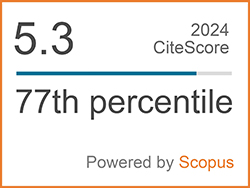S-Scheme ZnO/g-C3N5 Visible Light Active Photocatalyst for Rhodamine B Dye Degradation and Hg Sensing Applications
Abstract
Keywords
[1] Y. Luo, Q. Guo, J. Xu, H. Zhou, Z. Wang, and H. He, “Growth of BaTaO2N–BaNa0.25Ta0.75O3 solid solution photocatalyst for visible light-driven Z-scheme overall water splitting,” Energy Material Advances, vol. 2022, 2022, Art. no. 0003, doi: 10.34133/energymatadv.0003.
[2] K. Gurushantha, K. Keshavamurthy, S. Meena, N. Kottam, M. N. Manjunatha, S. Malini, S. Shashidhar, G. Shobha, and T. Ramakrishnappa, “Synthesis of heterojunction nanocomposites ZnFe2O4/ZnO/Nb2O5 for photocatalytic, capacitor and antibacterial applications,” Inorganic Chemistry Communications, vol. 162, 2024, Art. no. 112126, doi: 10.1016/j.inoche. 2024.112126.
[3] A. Thakur and H. Kaur, “Response surface optimization of Rhodamine B dye removal using paper industry waste as adsorbent,” International Journal of Industrial Chemistry, vol. 8, pp. 175–186, 2017, doi: 10.1007/s40090-017-0113-4.
[4] H. Nezzal, S. Rahmane, E. G.Temam, M. Al-Abri, H. H. Kyaw, B. Gasmi, M. Althamthami, H. B. Temam, and J. Hu, “Photo-deposition of AgO thin films on TiO2 substrate for (PN) hetero-junction applications: Considering the degree of contamination,” Journal of Alloys and Compounds, vol. 1010, 2025, Art. no. 177331, doi: 10.1016/j.jallcom.2024.177331.
[5] N. Mokrani, E. G. Temam, H. B. Temam, H. Barkat, M. Althamthami, “Enhancing water purification with light-activated strontium-doped ZnO thin films,” Advances in Natural Sciences: Nanoscience and Nanotechnology, vol. 16, no. 1, 2025, Art. no. 015012, doi: 10.1088/2043-6262/ ada005.
[6] B. Zhu, J. Sun, Y. Zhao, L. Zhang, and J. Yu, “Construction of 2D S‐scheme heterojunction photocatalyst,” Advanced Materials, vol. 36, no. 8, 2024, Art. no. 2310600, doi: 10.1002/adma. 202310600.
[7] H. Houda, G. T. Elhachmi, M. Althamthami, H. B. Temam, and S. Rahmane, “Property analysis of β-tetragonal bismite thin films: Varied concentrations and enhanced photocatalytic efficiency,” Iranian Journal of Materials Science & Engineering, vol. 21, no. 4, 2024, doi: 10.22068/ijmse.3514
[8] B. N. Roopashree, K. Gurushantha, Kottam Nagaraju, and S. Meena, “Recent review on s-scheme photocatalysis,” Water, Air, & Soil Pollution, vol. 235, no. 9, pp. 1–25, 2024, doi: 10.1007/s11270-024-07376-y
[9] N. Srinatha, S. S. Reddy, M. Al-Dossari, K. Gurushantha, N. S. A. EL-Gawaad, S. O. Manjunatha, K. J. R. Kumar, M. R. S. Kumar, V. B. Tangod, and A. Madhu, “Effect of aliovalent substitution in the band structure engineered Ca2+-doped LaFeO3 nanoparticles for visible light-induced photocatalytic studies,” Ceramics International, vol. 50, no. 1, pp. 1836–1848, 2024, doi: 10.1016/j.ceramint.2023.10.283.
[10] H. Nayak and B. Padhi, “Photocatalytic decomposition of methylene blue over nanosized Ca2+ doped LaMnO3 under visible light irradiation,” Asian Journal of Applied Chemistry Research, vol. 13, no. 3, pp. 39–49, 2023, doi: 10.9734/AJACR/2023/v13i3247.
[11] T. Xu, R. Wang, C. Gu, and T. Jiang, “Recyclable detection of gefitinib in clinical sample mediated by multifunctional Ag-anchored g-C3N4/MoS2 composite substrate,” Spectrochimica Acta Part A: Molecular and Biomolecular Spectroscopy, vol. 299, 2023, Art. no. 122801, doi: 10.1016/j.saa.2023.122801.
[12] Z. Wang, Z. Huang, J. Yu, X. Shao, W. Peng, J. Yu, and Y. Jiang, “Growth of Ag/g-C3N4 nanocomposites on nickel foam to enhance photocatalytic degradation of formaldehyde under visible light,” Journal of Environmental Sciences, vol. 137, pp. 432–442, 2024, doi: 10.1016/j.jes.2023.02.003.
[13] O. A. Oyewo, S. Ramaila, and L. Mavuru, “Adsorption and photocatalytic removal of murexide using ZnO/rGO and ZnO/g-C3N4 composites,” Inorganic Chemistry Communications, vol. 151, 2023, Art. no. 110601, doi: 10.1016/j.inoche.2023.110601.
[14] Y. He, H. Hu, J. Wang, X. Wang, M. Sun, C. Tian, and C. Deng, “Fabrication of multi-scale CdS/ZnO heteroarchitectures with boosted dual photocatalytic activities for hydrogen generation and organic dye degradation under solar light,” Materials Research Bulletin, vol. 162, 2023, Art. no. 112180, doi: 10.1016/j.materresbull.2023. 112180.
[15] X. Xie and E. Bakker, “Ion selective optodes: From the bulk to the nanoscale,” Analytical and Bioanalytical Chemistry, vol. 407, pp. 3899–3910, 2015, doi: 10.1007/s00216-014-8413-4.
[16] E. Sacher and R. França, “Dental biomaterials,” World Scientific, vol. 2, 2018, doi: 10.1142/10589.
[17] S. Chilov, “Determination of small amounts of mercury,” Talanta, vol. 22, no. 3, pp. 205–232, 1975, doi: 10.1016/0039-9140(75)80059-2.
[18] F. Edition, “Guidelines for drinking-water quality,” WHO Chronicle, vol. 38, no. 4, pp. 104–108, 2011.
[19] M. R. Rahman, T. Okajima, and T. Ohsaka, “Selective detection of As (III) at the Au (111)-like polycrystalline gold electrode,” Analytical Chemistry, vol. 82, no. 22, pp. 9169–9176. 2010, doi: 10.1021/ac101206j.
[20] V. Adimule, R. Keri, S. Rajendrachari, P. Kendrekar, and C. V. Kulkarni, “Highly photoluminescence and wide band gap insulating metal hybrid nanoparticles array of samarium-doped SrO: CoO: Synthesis, characterizations and sensor characteristics,” Journal of Materials Science: Materials in Electronics, vol. 34, no. 5, p. 442, 2023, doi: 10.1007/s10854-023-09899-2.
[21] D. W. M. Arrigan, “Tutorial review. Voltammetric determination of trace metals and organics after accumulation at modified electrodes,” Analyst, vol. 119, no. 9, pp. 1953–1966, 1994, doi: 10.1039/AN9941901953.
[22] N. A. Bohari, S. Siddiquee, S. Saallah, M. Misson, and S. E. Arshad, “Electrochemical behaviour of real-time sensor for determination mercury in cosmetic products based on PANI/MWCNTs/AuNPs/ITO,” Cosmetics, vol. 8, no. 1, p. 17, 2021, doi: 10.3390/cosmetics8010017.
[23] H. Barkat, E. G. Temam, H. Ben Temam, N. Mokrani, S. Rahmane, and M. Althamthami, “Enhancing sunlight-driven photocatalysis: High transparency and hydrophilic advancements in Ba-Doped ZnO thin films,” Journal of Materials Engineering and Performance, pp. 1–14, 2024, doi: 10.1007/s11665-024-10126-0.
[24] N. Mokrani, E. G. Temam, H. Barkat, H. B. Temam, S. Rahmane, and M. Althamthami, “Boosting photocatalytic stability: Hydrophilic Sr-doped ZnO thin films prepared via the SILAR method for enhanced performance over multiple cycles,” Physica Scripta, vol. 99, no. 9, 2024, Art. no. 0959a4, doi: 10.1088/1402-4896/ad6ffb.
[25] J. Jia, L. Huang, Y. Yan, H. Wang, M. Tian, and J. Jiang, “A novel S-scheme ZnO/Ce-g-C3N5 heterojunctions with enhanced photocatalytic activity,” Journal of Sol-Gel Science and Technology, vol. 111, no. 3, pp. 819–833, 2024, doi: 10.1007/s10971-024-06491-w.
[26] P. Kumar, E. Vahidzadeh, U. K. Thakur, P. Kar, Kazi M. Alam, A. Goswami, N. Mahdi, K. Cui, G. M. Bernard, V. K. Michaelis, and K. Shankar, “C3N5: A low bandgap semiconductor containing an azo-linked carbon nitride framework for photocatalytic, photovoltaic and adsorbent applications,” Journal of the American Chemical Society, vol. 141, no. 13, pp. 5415–5436, 2019, doi: 10.1021/jacs.9b00144.
[27] J. Liu, S. Wang, C. Zhao, and J. Zheng, “Engineered g-C3N5-based nanomaterials for photocatalytic energy conversion and environmental remediation,” Nanomaterials, vol. 13, no. 3, p. 499, 2023, doi: 10.3390/nano 13030499.
[28] A. Singh and H. L. Vishwakarma, “Study of structural, morphological, optical and electroluminescent properties of undoped ZnO nanorods grown by a simple chemical precipitation,” Materials Science-Poland, vol. 33, no. 4, pp. 751–759, 2015, doi: 10.1515/msp-2015-0112.
[29] M. Rostami, M. Jourshabani, F. Davar, G. M. Ziarani, and A. Badiei, “Black TiO2-g-C3N4 heterojunction coupled with MOF (ZIF-67)-derived Co3S4/nitrogen-doped carbon hollow nanobox,” Journal of the American Ceramic Society, vol. 107, no. 2, pp. 719–735, 2024, doi: 10.1111/jace.19447.
[30] E. Baladi, F. Davar, and A. Hojjati-Najafabadi, “Synthesis and characterization of g–C3N4–CoFe2O4–ZnO magnetic nanocomposites for enhancing photocatalytic activity with visible light for degradation of penicillin G antibiotic,” Environmental Research, vol. 215, 2022, Art. no. 114270, doi: 10.1016/j.envres.2022.114270.
[31] G. Xiong, U. Pal, J. G. Serrano, K. B. Ucer, and R. T. Williams, “Photoluminesence and FTIR study of ZnO nanoparticles: The impurity and defect perspective,” Physica Status Solidi C, vol. 3, no. 10, pp. 3577–3581, 2006, doi: 10.1002/pssc. 200672164.
[32] M. H. Sayadi, S. Ghollasimood, N. Ahmadpour, and S. Homaeigohar, “Biosynthesis of the ZnO/SnO2 nanoparticles and characterization of their photocatalytic potential for removal of organic water pollutants,” Journal of Photochemistry and Photobiology A: Chemistry, vol. 425, 2022, Art. no. 113662, doi: 10.1016/ j.jphotochem.2021.1136620.
[33] H. Wang, M. Li, Q. Lu, Y. Cen, Y. Zhang, and S. Yao, “A mesoporous rod-like g-C3N5 synthesized by salt-guided strategy: As a superior photocatalyst for degradation of organic pollutant,” ACS Sustainable Chemistry & Engineering, vol. 7, no. 1, pp. 625–631, 2018, doi: 10.1021/acssuschemeng.8b04182.
[34] J. H. Zheng, Q. Jiang, and J. S. Lian, “Synthesis and optical properties of flower-like ZnO nanorods by thermal evaporation method,” Applied Surface Science, vol. 257, no. 11, pp. 5083–5087, 2011, doi: 10.1016/j.apsusc.2011. 01.025.
[35] J. Chastain and R. C. King Jr, “Handbook of X-ray photoelectron spectroscopy,” Perkin-Elmer Corporation, vol. 40, p. 221, 1992.
[36] J. Das, S. K. Pradhan, D. R. Sahu, D. K. Mishra, S. N. Sarangi, B. B. Nayak, S. Verma, and B. K. Roul, “Micro-Raman and XPS studies of pure ZnO ceramics,” Physica B: Condensed Matter, vol. 405, no. 10, pp. 2492–2497, 2010, doi: 10.1016/j.physb.2010.03.020.
[37] J. Lee, J. Chung, and S. Lim, “Improvement of optical properties of post-annealed ZnO nanorods,” Physica E: Low-dimensional Systems and Nanostructures, vol. 42, no. 8, pp. 2143–2146, 2010, doi: 10.1016/j.physe.2010.04.013.
[38] C. Fu, T. Wu, G. Sun, G. Yin, C. Wang, G. Ran, and Q. Song, “Dual-defect enhanced piezocatalytic performance of C3N5 for multifunctional applications,” Applied Catalysis B: Environmental, vol. 323, 2023, Art. no. 122196, doi: 10.1016/j.apcatb.2022.122196.
[39] H. Wang, M. Li, Q. Lu, Y. Cen, Y. Zhang, and S. Yao, “A mesoporous rod-like g-C3N5 synthesized by salt-guided strategy: As a superior photocatalyst for degradation of organic pollutant,” ACS Sustainable Chemistry & Engineering, vol. 7, no. 1, pp. 625–631, 2018, doi: 10.1021/acssuschemeng.8b04182.
[40] S. Liu, Y. Bu, S. Cheng, and R. Tao, “Synthesis of TiO2/g-C3N5 heterojunction for photocatalytic degradation of methylene blue wastewater under visible light irradiation: Mechanism analysis,” Diamond and Related Materials, vol. 136, 2023, Art. no. 110062, doi: 10.1016/j.diamond.2023. 110062.
[41] Y. Liu, H. Liu, H. Zhou, T. Li, and L. Zhang, “A Z-scheme mechanism of N-ZnO/g-C3N4 for enhanced H2 evolution and photocatalytic degradation,” Applied Surface Science, vol. 466, pp. 133–140, 2019, doi: 10.1016/j.apsusc.2018. 10.027.
[42] K. Yousra, E. G. Temam, R. Saâd, and H. Barkat, “Effect of film thickness on the electrical and the photocatalytic properties of ZnO nanorods grown by SILAR technique,” Physica Scripta, vol. 98, no. 12, 2023, Art. no. 125954, doi: 10.1088/1402-4896/ad0ae7.
[43] Y. Zhang, D. L. Liu, B. Y. Xiong, J. L. Li, Y. T. Li, Y. L. Zhou, A. S. Yang, and Q. P. Zhang, “Constructing WO3/TiO2 heterojunction with solvothermal-sintering for enhanced photocatalytic activity under visible light irradiation,” Solid State Sciences, vol. 131, 2022, Art. no. 106963, doi: 10.1016/j.solidstatesciences. 2022.106963.
[44] B. Li, B. Zhang, Y. Zhang, M. Zhang, W. Huang, C. Yu, J. Sun, J. Feng, S. Dong, and J. Sun, “Porous g-C3N4/TiO2 S-scheme heterojunction photocatalyst for visible-light driven H2-production and simultaneous wastewater purification,” International Journal of Hydrogen Energy, vol. 46, no. 64, pp. 32413–32424, 2021, doi: 10.1016/j.ijhydene.2021.07.090.
[45] L. Zhang, J. Guo, B. Hao, and H. Ma, “WO3/TiO2 heterojunction photocatalyst prepared by reactive magnetron sputtering for Rhodamine B dye degradation,” Optical Materials, vol. 133, 2022, Art. no. 113035, doi: 10.1016/j.optmat.2022.113035.
[46] F. H. AlHamedi, M. A. Rauf, and S. S. Ashraf, “Degradation studies of Rhodamine B in the presence of UV/H2O2,” Desalination, vol. 239, no. 1–3, pp. 159–166, 2009, doi: 10.1016/ j.desal.2008.03.016.
[47] K. Gurushantha, K. S. Anantharaju, H. Nagabhushana, S. C. Sharma, Y. S. Vidya, C. Shivakumara, H. P. Nagaswarupa, S. C. Prashantha, and M. R. Anilkumar, “Facile green fabrication of iron-doped cubic ZrO2 nanoparticles by Phyllanthus acidus: Structural, photocatalytic and photoluminescent properties,” Journal of Molecular Catalysis A: Chemical, vol. 397, pp. 36–47, 2015, doi: 10.1016/j.molcata.2014.10.025.
[48] A. Trenczek-Zajac, M. Synowiec, K. Zakrzewska, K. Zazakowny, K. Kowalski, A. Dziedzic, and M. Radecka, “Scavenger-supported photocatalytic evidence of an extended type I electronic structure of the TiO2@ Fe2O3 interface,” ACS Applied Materials & Interfaces, vol. 14, no. 33, pp. 38255–38269, 2022, doi: 10.1021/acsami.2c06404.
[49] Y. Narita, K. Nishi, T. Matsuyama, and J. Ida, “Reusable isotype heterojunction g-C3N4/alginate hydrogel spheres for photocatalytic wastewater treatment,” RSC advances, vol. 14, no. 29, pp. 20898–20907, 2024, doi:10.1039/D4RA02876G.
[50] E. G. Temam, F. Djani, S. Rahmane, H. B. Temam, and B. Gasmi, “Photocatalytic activity of Al/Ni doped TiO2 films synthesized by sol-gel method: dependence on thickness and crystal growth of photocatalysts,” Surfaces and Interfaces, vol. 31, 2022, Art. no. 102077, doi: 10.1016/j.surfin.2022.102077.
[51] Y. Wang, Y. He, Y. Chi, P. Yin, L. Wei, W. Liu, X. Wang, H. Zhang, and H. Song, “Construction of S-scheme pn heterojunction between protonated g-C3N4 and α-MnS nanosphere for photocatalytic H2O2 production and in situ degradation of oxytetracycline,” Journal of Environmental Chemical Engineering, vol. 11, no. 3, 2023, Art. no. 109968, doi: 10.1016/ j.jece.2023.109968.
[52] C. Yang, J. Yang, S. Liu, M. Zhao, X. Duan, H. Wu, L. Liu, W. Liu, J. Li, S. Ren, and Q. Liu, “Constructing C–O bridged CeO2/g-C3N4 S-scheme heterojunction for methyl orange photodegradation: Experimental and theoretical calculation,” Journal of Environmental Management, vol. 335, 2023, Art. no. 117608, doi: 10.1016/j.jenvman.2023.117608.
[53] K. Bi, X. Qin, S. Cheng, and S. Liu, “ZnO/g-C3N4 S scheme photocatalytic material with visible light response and enhanced photocatalytic performance,” Diamond and Related Materials, vol. 137, 2023, Art. no. 110143, doi: 10.1016/j.diamond.2023.110143.
[54] J. Liu, G. Zhu, M. Chen, X. Ma, J. Yang, “Fabrication of electrospun ZnO nanofiber-modified electrode for the determination of trace Cd (II),” Sensors and Actuators B: Chemical, vol. 234, pp. 84–91, 2016, doi: 10.1016/j.snb. 2016.04.073.
[55] M. Amiri, H. Salehniya, and A. Habibi-Yangjeh, “Graphitic carbon nitride/chitosan composite for adsorption and electrochemical determination of mercury in real samples,” Industrial & Engineering Chemistry Research, vol. 55, no. 29, pp. 8114–8122, 2016, doi: 10.1021/acs.iecr. 6b01699.
[56] A. Das and M. K. Adak, “Kinetic and mechanistic way for photocatalytic degradation of pollutants from textile wastewater by graphene oxide supported nanocomposite,” Next Materials, vol. 3, 2024, Art. no. 100153, doi: 10.1016/j.nxmate.2024.100153.
[57] M. T. D. Español, E. J. G. Garcia, L. A. V. Maligaya, C. M. S. Santos, J. A. H. Santos, N. G. Suarnaba, R. V. C. Rubi, and R. Raguindin, “Ultrasound-assisted biomimetic synthesis of mof-hap nanocomposite via 10xsbf-like for the photocatalytic degradation of metformin,” Applied Science and Engineering Progress, vol. 17, no. 2, 2024, Art. no. 7251, doi: 10.14416/j.asep.2023.11.002.
[58] T. Q. Thao, N. T. T. Hien, P. T. Lam, N. N. Huy, P. T. Thi, N. T. Thanh, P. P. Toan, L. T. Thich, and N. T. Thuy, “Exploring the mechanism for the photocatalytic degradation of oxytetracycline in water using TiO2 and supplementary oxidants,” Applied Science and Engineering Progress, vol. 18, no. 3, 2025, Art. no. 7651, doi: 10.14416/j.asep.2024.11.007.
[59] N. Kottam, K. R. Jammula, S. J. Shivaram, B. A. Rajappa, P. Narayanappa, S. S. P. Nair, and A Tawai, “Design and development of g-C3N4/ZnO/CdS ternary photocatalyst for the removal of environmentally hazardous organic dyes under visible light,” Applied Science and Engineering Progress, vol. 18, no. 3, 2025, Art. no. 7654, doi: 10.14416/j.asep.2024.11.008.
[60] F. B. Sousa, Maria, É. J. Dallan, S. B. Yamaki, and R. Bertazzoli, “Preparation of polymer-coated electrodes containing metal ions complexing sites by electropolymerization of 2-mercaptobenzimidazole and 2-mercaptobenzothiazole on glassy carbon,” Electroanalysis, vol. 9, no. 8, pp. 614–618, 1997, doi: 10.1002/elan.1140090807.
[61] R. G. Kempegowda and P. Malingappa, “Diazonium functionalized exfoliated graphitic carbon as a binderless and covalently modified electrochemical interface for mercury sensing,” Sensors and Actuators B: Chemical, vol. 186, pp. 478–485, 2013, doi: 10.1016/j.snb.2013.06.028.
[62] H. Yi, “Anodic stripping voltammetric determination of mercury using multi-walled carbon nanotubes film coated glassy carbon electrode,” Analytical and Bioanalytical Chemistry, vol. 377, pp. 770–774, 2003, doi: 10.1007/s00216-003-2136-2.
[63] B. C. Janegitz, L. C. S. Figueiredo-Filho, L. H. Marcolino-Junior, S. P. Souza, E. R. Pereira-Filho, and O. Fatibello-Filho, “Development of a carbon nanotubes paste electrode modified with crosslinked chitosan for cadmium (II) and mercury (II) determination,” Journal of Electroanalytical Chemistry, vol. 660, no. 1, pp. 209–216, 2011, doi: 10.1016/j.jelechem.2011. 07.001.
[64] O. Abollino, A. Giacomino, M. Malandrino, G. Piscionieri, and E. Mentasti, “Determination of mercury by anodic stripping voltammetry with a gold nanoparticle-modified glassy carbon electrode,” Electroanalysis: An International Journal Devoted to Fundamental and Practical Aspects of Electroanalysis, vol. 20, no. 1, pp. 75–83, 2008, doi: 10.1002/elan.200704044.DOI: 10.14416/j.asep.2025.06.001
Refbacks
- There are currently no refbacks.
 Applied Science and Engineering Progress
Applied Science and Engineering Progress







